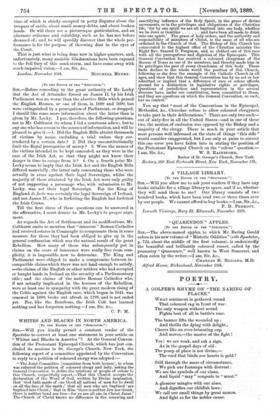WHITES AND BLACKS IN NORTH AMERICA.
[To Tag EDITOR OP THE "SplicTsTos..-] SIR,—Will you kindly permit a constant reader of the Spectator to correct at least one statement in your article on "Whites and Blacks in America "P At the General Conven- tion of the Protestant Episcopal Church, which has just con- cluded its sessions in St. George's Church, New York, the following report of a committee appointed by the Convention to reply to a petition of coloured clergy was adopted:— " The Joint Committee [committee from both houses], to whom was referred the petition of coloured clergy and laity, asking the General Convention to define the relations of people of colour to this Church, respectfully report,—That this Church accepts the declaration of the Word of God, written by Divine inspiration, that God hats made of cne blood all nations of men for to dwell on all the face of the earth;' that all men who are baptised are baptised into Christ;' th0 in Him 'there is neither Jew nor Greek, there is neither lend nor free—for ye are all one in Christ Jesus.' The Church of Christ knows no difference in the renewing and sanctifying influence of the Holy Spirit, in the grace of divine sacraments, or in the privileges and obligations of the Christian life, for by one spirit we are all baptised into one body, whether we be Jews or Gentiles and have been all made to drink into one spirit.' The grace of holy orders, and the authority and responsibility of ministers of Christ, is the same of all who are ordained in the Church of God. The Bishop of this Church has consecrated to the highest office of the Christian ministry the Right Rev. Samuel D. Ferguson, and so clothed one of this race- with 811 the prerogatives and dignities of the Episcopate. This General Convention has received a coloured clergyman of the diocese of Texas as one of its members, and thereby made him in its privileges the peer of every churchman of this body. These facts declare to the whole world the position of this Church, following as she does the example of the Catholic Church in all ages, and show that this General Convention has by no act or law admitted or implied that a difference of race or colour affords ground for a distinction in legislative rights or privileges Questionsof jurisdiction and representation in the several dioceses have, under our constitution, been committed to them, and they are questions on which the General Convention, as such,. has no control."
You say that "most of the Conventions in the Episcopal, Methodist, Ste., Churches refuse to allow coloured clergymen to take part in their deliberations." There are only two such— out of sixty-five in all the -United States—and in one of these two, the motion of exclusion was opposed by the Bishop and a majority of the clergy. There is much in your article that most persons well informed on the state of things "this side ' would consider exaggerated, but I am only at pains to correct this one error you have fallen into in stating the position of the Protestant Episcopal Church on the "colour" question.—
Rector of St. George's Church, New York.
Rectory, 209 East Sixteenth Street, New York, November 7th.






































 Previous page
Previous page